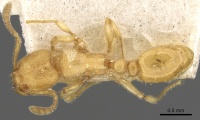Tetramorium elisabethae
| Tetramorium elisabethae | |
|---|---|

| |
| Scientific classification | |
| Kingdom: | Animalia |
| Phylum: | Arthropoda |
| Class: | Insecta |
| Order: | Hymenoptera |
| Family: | Formicidae |
| Subfamily: | Myrmicinae |
| Tribe: | Crematogastrini |
| Genus: | Tetramorium |
| Species group: | inglebyi |
| Species: | T. elisabethae |
| Binomial name | |
| Tetramorium elisabethae Forel, 1904 | |
Nothing is known about the biology of Tetramorium elisabethae.
Identification
Bolton (1977) - T. elisabethae does not have any known close relatives, but the reduced eyes, short frontal carinae and the specialized shape of the gaster seem to indicate relationship with Tetramorium inglebyi and Tetramorium myops, although in other aspects such as the short propodeal spines and broad node its affinities lie in the direction of the caespitum-group.
Keys including this Species
Distribution
Distribution based on Regional Taxon Lists
Oriental Region: India (type locality).
Distribution based on AntMaps
Distribution based on AntWeb specimens
Check data from AntWeb
Countries Occupied
| Number of countries occupied by this species based on AntWiki Regional Taxon Lists. In general, fewer countries occupied indicates a narrower range, while more countries indicates a more widespread species. |

|
Estimated Abundance
| Relative abundance based on number of AntMaps records per species (this species within the purple bar). Fewer records (to the left) indicates a less abundant/encountered species while more records (to the right) indicates more abundant/encountered species. |

|
Biology
Castes
Nomenclature
The following information is derived from Barry Bolton's Online Catalogue of the Ants of the World.
- elisabethae. Tetramorium elisabethae Forel, 1904c: 20 (w.) INDIA. See also: Bolton, 1977: 111.
Unless otherwise noted the text for the remainder of this section is reported from the publication that includes the original description.
Description
Worker
Bolton (1977) - TL 2.9-3.1, HL 0.68-0.74, HW 0.60-0.64, CI 86-90, SL 0.50-0.52, SI 80-83, PW 0.44-0.50, AL 0.78-0.84 (5 measured).
Mandibles feebly striate; true anterior clypeal margin entire but the narrow lamellate apron or flange indented medially, the intensity of the indentation variable. Frontal carinae very short, ending before or at the level of the anterior margins of the eyes. Antennal scrobes absent. Eyes very small, with only about seven facets, the maximum diameter c. 0.06. Propodeal spines short and triangular, dentiform and feebly upcurved. Metapleural lobes broad and rounded. Petiole node relatively high in profile, the height of the tergal portion greater than the dorsal length. In dorsal view both nodes distinctly broader than long, rounded and without angles. Base of first gastral tergite strongly concave and accommodating the posterior margin of the postpetiole. On each side of this the anterolateral portions of the tergite are angular and project forwards. Dorsum of head with very fine but quite dense, predominantly longitudinal rugulation, and with faint reticulation on the sides above the eyes. Dorsal alitrunk somewhat more conspicuously rugulose than the head, feebly reticulate in places. Petiole, postpetiole and gaster unsculptured. AH dorsal surfaces of head and body with quite dense short, fine hairs, the majority of which are suberect to subdecumbent. On the scapes and hind tibiae the hairs are shorter and subdecumbent to decumbent. Colour uniform pale yllow.
Type Material
Bolton (1977) - Syntype workers, India: Sind Valley, Kashmir (Wroughton) (Musee d'Histoire Naturelle Genève; Museum of Comparative Zoology; The Natural History Museum) [examined].
References
- Agavekar, G., Hita Garcia, F., Economo, E.P. 2017. Taxonomic overview of the hyperdiverse ant genus Tetramorium Mayr (Hymenoptera, Formicidae) in India with descriptions and X-ray microtomography of two new species from the Andaman Islands. PeerJ 5:e3800 (DOI 10.7717/peerj.3800).
- Bharti, H. & Kumar, R. 2012. Taxonomic studies on genus Tetramorium Mayr (Hymenoptera, Formicidae) with report of two new species and three new records including a tramp species from India with a revised key. ZooKeys. 207:11-35. doi:10.3897/zookeys.207.3040
- Bolton, B. 1977. The ant tribe Tetramoriini (Hymenoptera: Formicidae). The genus Tetramorium Mayr in the Oriental and Indo-Australian regions, and in Australia. Bulletin of the British Museum (Natural History). Entomology. 36:67-151. 36: 67-151 (page 111, see also)
- Forel, A. 1904d. Miscellanea myrmécologiques. Rev. Suisse Zool. 12: 1-52 (page 20, worker described)
- Subedi, I.P., Budha, P.B., Bharti, H., Alonso, L. 2020. An updated checklist of Nepalese ants (Hymenoptera, Formicidae). ZooKeys 1006, 99–136 (doi:10.3897/zookeys.1006.58808).

